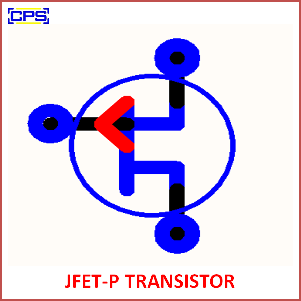A JFET-P transistor (Junction Field Effect Transistor – P-channel) is a type of field-effect transistor (FET) that operates similarly to an N-channel JFET but with an inverted configuration where the current flows through a P-type semiconductor channel instead of an N-type channel. In a P-channel JFET, the current carriers are holes (positively charged particles), and the flow of current is controlled by the voltage applied to the gate.

Key Features of JFET-P:
- P-Channel:
- The channel through which current flows is made of p-type semiconductor material.
- The current carriers are holes, which are slower than electrons, making P-channel JFETs less efficient than N-channel JFETs in terms of current conduction.
- Gate Control:
- The gate is reverse-biased, meaning it does not conduct current under normal operation. A negative gate voltage (relative to the source) creates a depletion region, reducing the width of the channel and thus limiting the current flow.
- The channel becomes fully depleted and blocks current when the gate voltage reaches a threshold, known as the pinch-off voltage.
- Depletion Mode:
- Similar to the N-channel JFET, the P-channel JFET operates in depletion mode, meaning that increasing negative gate voltage reduces the current flow until it is completely cut off.
Applications:
- Amplifiers: P-channel JFETs can be used in audio and radio-frequency amplifiers.
- Switching Circuits: Often used in combination with N-channel JFETs in digital and analog circuits as switches.
- Voltage-Controlled Resistors: P-channel JFETs can be used to create variable resistors in certain applications.
Advantages:
- High Input Impedance: P-channel JFETs have high input impedance, which allows them to be used in low-power signal processing applications without loading the signal source.
- Low Noise: Since the gate is reverse-biased, P-channel JFETs exhibit low noise, making them suitable for low-noise applications like amplifiers.
- Simple Construction: Like other FETs, they are simple to fabricate and control.
Disadvantages:
- Lower Efficiency: Due to the use of holes as current carriers (which are less mobile than electrons), P-channel JFETs generally have lower performance in terms of current conduction compared to N-channel JFETs.
- Non-Linear Behavior: Like N-channel JFETs, P-channel JFETs exhibit non-linear characteristics, which can limit their applications in some high-precision circuits.
In summary, a P-channel JFET is a useful electronic component for amplification, switching, and other analog applications. It operates similarly to the N-channel JFET but with opposite current conduction characteristics due to the use of a P-type semiconductor channel.
